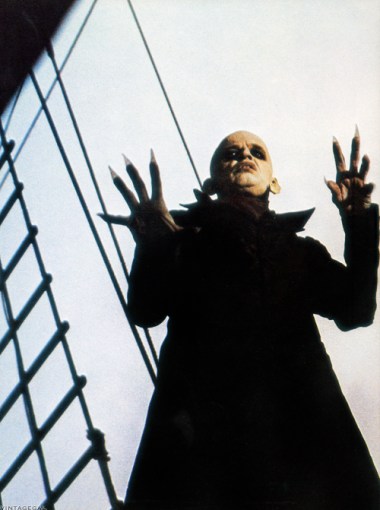
Nosferatu the Vampyre is a 1979 West German vampire horror film – Nosferatu: Phantom der Nacht (“Nosferatu: Phantom of the Night”) – written and directed by Werner Herzog. The film is set primarily in 19th century Wismar, Germany and Transylvania, and was conceived as a stylistic remake of the 1922 German Dracula adaptation, Nosferatu, eine Symphonie des Grauens. It stars Klaus Kinski as Count Dracula, Isabelle Adjani as Lucy Harker, Bruno Ganz as Jonathan Harker, and French artist-writer Roland Topor as Renfield.
Herzog’s production of Nosferatu was very well received by critics and enjoyed a comfortable degree of commercial success.
Plot teaser:
Jonathan Harker is an estate agent in Wismar, Germany. His boss, Renfield, informs him that a nobleman named Count Dracula wishes to buy a property in Wismar, and assigns Harker to visit the count and complete the lucrative deal.
Leaving his young wife Lucy behind in Wismar, Harker travels for four weeks to Transylvania, to the castle of Count Dracula. He carries with him the deeds and documents needed to sell the house to the Count.
On his journey, Jonathan stops at a village, where locals plead for him to stay clear of the accursed castle, providing him with details of Dracula’s vampirism. Harker ignores the villagers’ pleas as superstition, and continues his journey unassisted. Harker arrives at Dracula’s castle, where he meets the Count, a strange, ancient, almost rodent-like man, with large ears, pale skin, sharp teeth, and long fingernails…
Buy Blu-ray from Amazon.com
Reviews:
“There’s a hallucinatory quality to Herzog’s vampiric saga that often drags momentum down to the point of torpor. Yet like so much of the German director’s fictional output from this period, what’s sought isn’t excitement or horror in a traditional sense but, rather, an enveloping atmosphere of unreality, of madness, of the animalism that belies civilized society and human behavior.” Green Cine Daily
“It isn’t very often that a horror movie rises to the level of high art (hell, thousands of them can’t even make it to low art!), but with Nosferatu the Vampyre, Werner Herzog has pulled off precisely that. The movie is absolutely beautiful to behold, displaying Herzog’s remarkable mastery of his medium with every frame. The director’s use of light and shadow is fully up to the very high standard set by Murnau, and Herzog proves equally up to the considerable challenge of replicating the earlier film’s grim, moody atmosphere on color film.” 1000 Misspent Hours
Buy Limited Edition BFI Blu-ray Steelbook from Amazon.co.uk
“Herzog is the only director that I know of to openly embellish the only alluded to themes of vermin and plague from the Stoker novel. Dracula brings with him the rats (!) and with them comes the black plague. This leads to eerie scenes of coffin parades through the nearly deserted streets and of a last supper where plague-stricken revelers partake in an outdoor feast while rats swarm around their feet under the table.” Lisa Thatcher
Buy autobiography Kinski Uncut from Amazon.com | Amazon.co.uk
Related:




